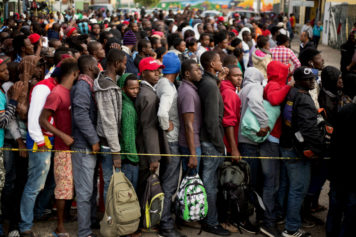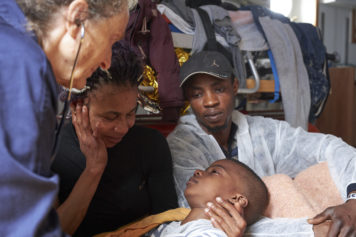
African migrants arriving in Italy. Source: IOM (weblog.iom.int)
The Italian government is considering a new policy that may force African migrants to perform free labor as a condition for asylum, underscoring the harsh reality — even modern-day enslavement — facing Black people in the European country.
Under a proposal introduced by Marco Minniti, Italy’s Interior Minister, thousands of Black migrants will be required to engage in “socially useful” work as their asylum claims are processed, The Times reported. The plan also would expedite the expulsions of economic migrants.
Last year, a record 181,000 migrants arrived in Italy via the Mediterranean Sea, and between January and October of last year, nearly 100,000 Black people, mostly from sub-Saharan Africa, applied for asylum. They live in crowded migrant centers and are allowed to work while they wait for their applications to process, typically for pennies in the fields. Italy has attracted migrants from all over, Eastern Europeans as well, due to the agriculture industry and the conditions they face at home. For Africans, Southern Italy has been a popular destination due to its proximity to the North African coast.
Some towns already ask refugees to perform “community service” in the form of street sweeping and cleaning parks and gardens, according to The Telegraph. “It allows people to get to know the foreigners and understand they are not just people you see on street corners,” said Luca Menesini, the mayor of Capannori in Tuscany. Up until now, those efforts have been voluntary. However, under the new government plan to be proposed by Minniti, labor would be mandatory, possibly as a requirement to receive a weekly living allowance.
According to a 2012 report from Amnesty International, Italy’s agricultural sector is highly reliant on migrant labor, which accounts for a quarter of the days worked and probably amounts to even more. Amnesty has criticized Italy for its criminalization of undocumented migrants, which it says allows this labor exploitation to thrive. The report also found that exploitation of migrant labor is widespread, particularly in Southern Italy. As was reported by the American Sociological Association.
Southern Italian agriculture is known for low wages, where farm workers who harvest tomatoes are made to live in ghettos, shantytowns and abandoned houses. According to Amnesty, these migrants, who are paid as little as €25 a day, ($27) “live in derelict buildings and makeshift shelters without running water, electricity or heating.” Further, 86 percent of workers do not have an employment contract and are paid under the table, according to the Italian aid group Doctors for Human Rights. “We were working from 6 in the morning to 6 in the evening, every day of the week, for 20 euros a day,” ($21) said Kojo, a migrant worker from Togo, in the Amnesty report. “We could not take breaks, not even for eating. We used to eat the oranges on the trees.”
The exploitation is not limited to agriculture but extends also to construction, where gangs and mafia-type criminal organizations maintain an oppressive contract-labor system that has become known as caporalato. Though illegal, the practice is common. Italian trade unions estimate that between 300,000 and 400,000 mostly African laborers are subjected to caporalato conditions, according to AFP. Further, Amnesty notes that nonpayment of wages is common, and the Italian justice system has failed to protect the victims of these labor abuses.
The abuse of African migrants also extends to children. The UN refugee agency found that nearly 26,000 unaccompanied minors came to Italy last year, more than twice the number from 2015, The Telegraph reported. Most were from Eritrea, Nigeria, Gambia and Egypt, and are especially susceptible to abuse and exploitation. Many are forced into prostitution.
In addition, African asylum seekers are subjected to deplorable living conditions in the detention facilities. According to The Local, protests broke out in the Cona migrant center in the Veneto region of Italy following the death of a 25-year-old woman named Sandrine Bakayoko, an Ivory Coast native, from a blood clot on January 4. Workers at the facility reportedly waited several hours before calling an ambulance. Asylum seekers reportedly cut the electricity to the facility and set fire to furniture and other items. Meanwhile, 25 staff members barricaded themselves inside a room overnight, according to The Local.
Members of parliament who visited the center last November denounced the “serious structural deficiencies” they witnessed. One MP condemned the poor living conditions, including lack of water and light, calling the facility a “ticking time bomb.” More than 1,400 people were housed in an area meant for only 15 people.
Italy is now using the revolt as grounds to speed up the deportations of Africans. “We have saved many lives, but we cannot accept rule-breaking. We need to speed up deportations,” Italian Foreign Minister Angelino Alfano said in an interview with La Stampa daily.
“When I’m in government, there will be mass expulsions, center closures and the Navy ships will send people back after saving them,” far-right leader Matteo Salvini of the Northern League wrote on Facebook. “Enough! 2017 will be the year of sending them back.”
Why do the Africans come in the first place? Thousands are crossing the Mediterranean to Europe through Libya, often risking their lives, in order to find a better life. The toppling of Libyan leader Muammar Gaddafi created a power vacuum, rendering the country’s 1,100-mile coastline an open border and allowing gangs to smuggle migrants in overcrowded sea vessels, as MSNBC reported. Unlike Syrian refugees who are fleeing a catastrophic civil war, those who arrive in Italy from sub-Saharan Africa are leaving due to extreme economic deprivation, oppressive governments and terrorist groups.
Eritrea, for example, accounted for the largest number of migrants at 40,000 in 2015. The country is not at war but rather is known for having one of the worst human rights records in the world. It was included in the 12 “Worst of the Worst” nations for civil liberties and political rights by the 2015 Freedom House report. For those living in these countries, stories on social media of family members making it to Europe and even sending remittances back home create a sense of hope and encourage people to continue to make the treacherous journey that has cost thousands of lives.
For those living in these countries, stories on social media of family members making it to Europe and even sending remittances back home create a sense of hope and encourage people to continue to make the treacherous journey that has cost thousands of lives.
Meanwhile, these types of deplorable conditions and attitudes against African migrants and asylum seekers are increasing across Europe, causing Africans to face a bitter new wave of exploitation, criminalization and modern-day enslavement in a country that does not want them.


